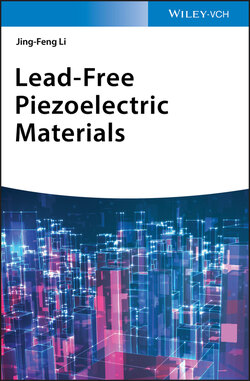Читать книгу Lead-Free Piezoelectric Materials - Jing-Feng Li - Страница 14
1.2 Piezoelectric Effects and Related Equations
ОглавлениеThe piezoelectric effect or piezoelectricity is the generation of electric charges on the surface of certain non‐conducting materials in response to applied mechanical stress, or conversely, the generation of a mechanical strain in such materials when they are subjected to an electric field, as schematically shown in Figure 1.1 [17]. The piezoelectric effect is a reversible process, so the materials exhibiting the direct piezoelectric effect also exhibit the converse piezoelectric effect. As such, piezoelectricity is referred to as both direct and converse effects, even though the word “piezoelectricity” often leads us to the meaning of the direct piezoelectric effect of the internal generation of electrical charges resulting from an applied mechanical force.
Figure 1.1 (a) The direct piezoelectric effect provides an electric charge upon application of a mechanical stress, whereas (b) the converse piezoelectric effect describes the situation where strain develops under an applied electric field.
Source: Reproduced with permission from Roedel and Li [17]. Copyright 2018, Cambridge University Press.
In a narrow sense, piezoelectricity can be understood as a linear electromechanical interaction between the mechanical and the electrical states. The constant for such a linearly proportional relation is defined as the piezoelectric coefficient d, which is a third‐rank tensor coupling the first‐rank tensor or vector (electric displacement or field) and the second‐rank tensor (stress or strain). Hence, the piezoelectric equations may be written in the following form (i, j, k = 1, 2, 3) [22]
(1.1)
(1.2)
where Di is electric displacement (C/m2), Ei is electric field component (V/m), Sij is strain component, Τij is stress component (N/m2), and dkij or dkij* is component of the piezoelectric charge or strain constant. It should be noted that the subscripts of piezoelectric constant are commonly expressed using the reduced Voigt matrix notation dkm, where k denotes the component of electric displacement D or field E in the Cartesian reference frame (x1, x2, x3), and the index m = 1, …, 6 is used to define the mechanical stress or strain. In this case, m = 1, 2, and 3 correspond to the normal stresses along the x1, x2, and x3 axes, respectively, whereas m = 4, 5, and 6 stand for the shear stresses Τ23, Τ13, and Τ12, respectively. Both d and d* are called the piezoelectric constant or coefficient, but they have different units, which are pC/N and pm/V (here, p stands for 10−9), respectively. It follows from thermodynamic considerations that dkm = dkm*, namely, the coefficients that connect the field and strain are equal to those connecting the stress and the polarization.
In addition to the piezoelectric charge or strain constant, other forms of piezoelectric constants are also used in specialized design cases. Totally, there are four piezoelectric constants including the abovementioned piezoelectric charge or strain coefficient d, which are listed in Table 1.1 with their names and definitions [22]. These piezoelectric constants are defined as partial derivatives evaluated at constant stress (subscript T), constant electrical field (subscript E), constant electrical displacement (subscript D), or constant strain (subscript S). These conditions can be regarded as “mechanically free,” “short circuit,” “open circuit,” and “mechanically clamped,” respectively.
